Analog
QUADRIGA•Video RF is the next generation tool, to transfer analog video tapes e.g. Betacam SP into files for networked TV- or video-production and for archiving and preservation. It is scalable from manually controlled single channel ingest workstations up to a fully automated migration factory.
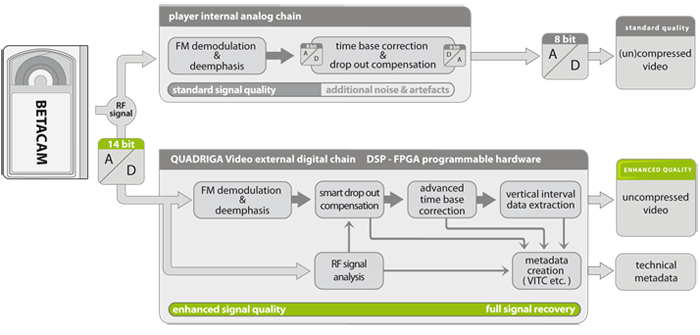
The technology behind QUADRIGA•Video RF
The complete transfer path from off-tape RF to the target file format is digitally processed. By substituting the traditional analog video playback path with optimized software algorithms, ultimate assessment of signal quality, error reporting and error compensation is possible.
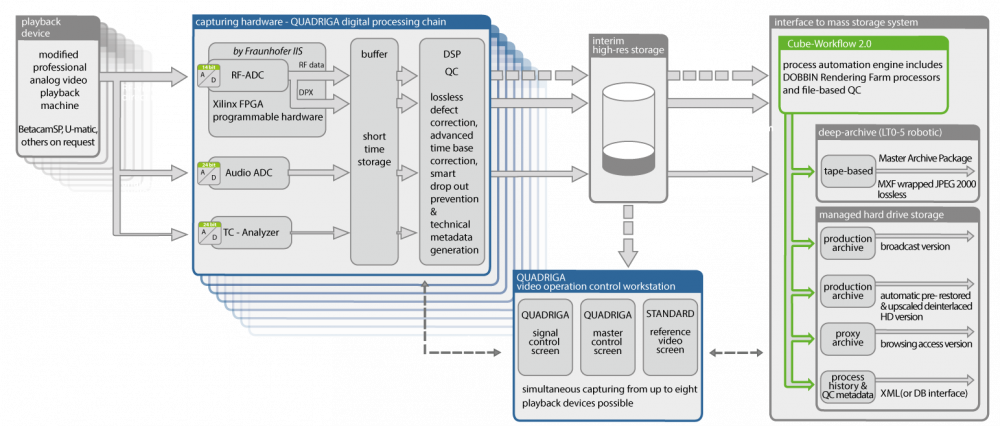
Quality assessment and control is an integral part of the system. Full confidence in the transfer process can be achieved. The ingest workflow is highly streamlined and insensitive for operational errors. Comprehensive sets of metadata are created for further processing, storage and retrieval in any content- or media asset management system.
All mainstream analog video recording formats are supported, e.g. component recording like Betacam® and BetacamSP® or color-under recording like U-matic® (low band, high band, SP).
Open industry-standard codec- and fileformats ensure best possible interoperability with other vendor´s systems and facilitates interchange and interoperability of formats.
QUADRIGA•Video RF´s open system concept allows full compatible integration with other Cube-Tec products like DOBBIN and CubeWorkflow 2.0.
Modification of Sony BVW Series Betacam Devices for QUADRIGA•Video RF Readout
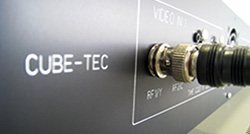
Simple but efficient
In order to modify simply open your machine and remove the DEC-42 board, if you are modifying a recorder. This is not needed for playback. In pure player devices the slot next to the DM-56 board will be already empty.
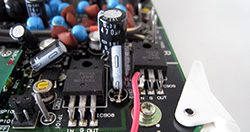
The DM-56 board has to be taken out and modified.
You only have to solder the supplied cables onto the Y/C demodulator board in order to directly tap the off-tape RF signals.
The next step is to open the back of the machine and solder the second set of supplied cables to two existing BNC connectors. For example, two of the composite outputs may be used to serve as outputs for the direct RF read out after modification.
Place the modified Y/C demodulator in its allocated space.
Than connect the QUADRIGA•Video RF Amplifier board and place it in the free slot next to the DM-56 board.
Now your device is ready to be connected to the external QUADRIGA•Video RF Digitizer. You are now able to digitize with 14 bit for a maximum of signal quality.
Smart Drop-Out Prevention
The software-based “smart drop-out prevention” allows dynamic setting of drop-out detection levels within the digital RF signal and enables proper signal demodulation superior to analog drop out detection used in conventional VTRs. In case of unrecoverable drop-outs, metadata documents the exact occurance and sophisticated concealment algorithms can be used to compensate signal degradation on a highly advanced level.
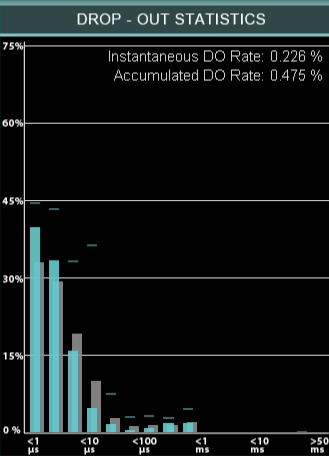
File Format and Codec Support
Various file wrapper formats are in use by the industry today, depending on the applications. The most common format used in TV-, video-production and archiving is MXF which is supported by QUADRIGA•Video RF as standard. Special MXF flavor like Master Archive Package (MAP) are ready to use.
Industry standard video codec support
Commonly used video signal compressions like MPEG-2 Intra-frame (D-10) for 30, 40 or 50 Mbps and DVC-Pro 25/50 for SD-Video are supported by Cube-Tec systems as standard. Other open coding schemes, e.g. lossless JPEG 2000 are optional.
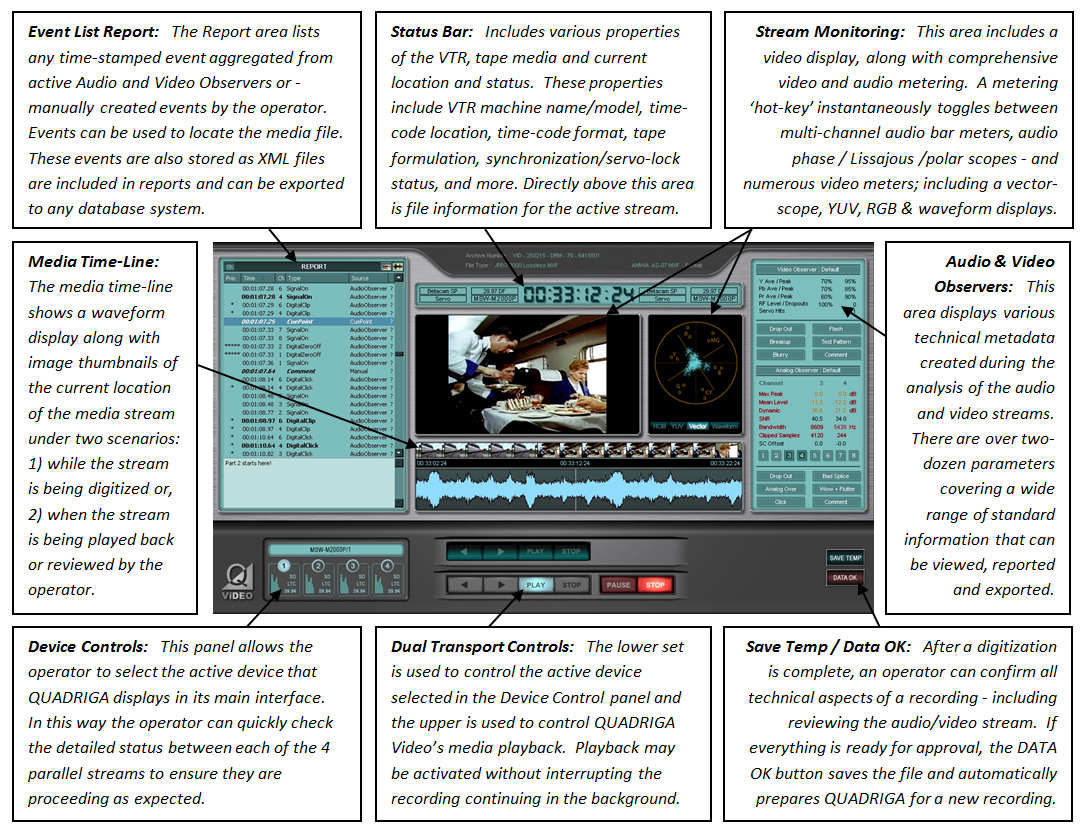
Seamless Integration with Cube-Tec's Dobbin and CubeWorkflow 2.0 Systems
QUADRIGA•Video RF generates all content and data for efficient further file-based batch processing in the DOBBIN rendering farm, where file conversion, transcoding, transformation, conformance checks and management of descriptive and technical metadata is handled. Each step in the workflow can be designed and controlled by the new CubeWorkflow 2.0, an easy to use VISIO-like web-access based graphical user interface for optimization of automated workflows.
Easy SOA integration

Service oriented architectures are used more and more in modern networked and file-based TV- and video production installations.
QUADRIGA•Video RF and other Cube-Tec building blocks can easily be integrated into other vendors SOA-based infrastructures as essential part of ingest, transfer or archiving jobs.
QUADRIGA•Video RF already supports the open standard Framework for Interoperable Media Services developed in cooperation with the European Broadcasting Union and the Advanced Media Workflow Association.
Loudness Normalization

The EBU´s recommendation R128 is now widely accepted and describes methods for automatic loudness control for playout, ingest or transfer in TV production. Cube-Tec systems already support R128 (ITU-R BS.1770-2).
The implementation in QUADRIGA•Video RF is optional, depending on the application and workflow design.
Multiple Metadata Creation and Support
A comprehensive set of metadata is essential for further storage and meaningful retrieval of archived content. A significant set of technical metadata is created during the signal processing, which is used to best describe the signal characteristics and improves the possibilities for preservation and successive restoration.
Technical and descriptive metadata can be formatted for use in any archive- or asset management system. Quality control is still in its infancy and industry initiatives are developing common guidelines. The system is already set up to implement data for next generation quality check and control.

